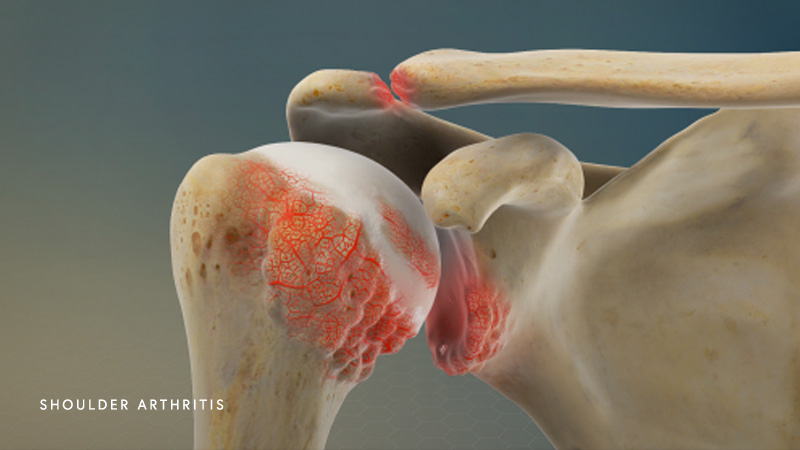Shoulder Arthritis
Shoulder arthritis is a painful and irritating condition that affects the ball-and-socket joint of the shoulder. There are many forms of arthritis, yet the two most commonly experienced in the shoulder are rheumatoid arthritis and osteoarthritis. Arthritis degenerates cartilage that is fundamental in the range of motion and overall function of the shoulder.
The shoulder, much like the hip, is a ball-and socket type joint that connects bones together allowing for a wide range of motion. The shoulder joint connects the humerus to the scapula through a series of muscles, tendons, ligaments and cartilage. The collarbone (clavicle) attaches to both the chest (sternum) and the shoulder blade (scapula). The clavicle also attaches to the front of the shoulder (acromion) through the acromioclavicular joint. At the front of the shoulder, the scapular spine houses the pectoral muscles and the glenohumeral joint (the ball and socket portion of the shoulder).
The rotator cuff beneath the acromion and the bursa houses many tendons and muscles that allow for the dexterity of the shoulder. These tendons are the supraspinatus, infraspinatus, teres minor, and subscapularis. The subscapularis is located at the back of the shoulder by the scapula and attaches the scapula to the rotator cuff.
There are two types of cartilage found in the shoulder: articular cartilage and meniscus cartilage. Articular cartilage is the smooth layer of soft tissue that blankets the ends of bones that attach to one another through muscles, tendons, and ligaments. This cartilage allows for the smooth and gliding motion of the bones within the shoulder joint. Meniscus cartilage lines the socket of the scapula and acts as a stabilizer and shock absorber. Arthritis has been known to deteriorate cartilage and cause tenderness within the shoulder joint.
There are two types of arthritis that commonly affect the shoulder: osteoarthritis and rheumatoid arthritis. Arthritis is a degenerative disease within the body that eats away at cartilage and causes the bones that make up joints in the body to aggressively grind together and damage one another. Arthritis contributes to the tenderness and swelling of joints within the body. Uric acid crystals form when there is too much uric acid in the bloodstream. This can cause gout in the joints. Infections or underlying diseases, such as psoriasis or lupus, can also cause other types of arthritis.

Shoulder arthritis is most commonly caused by two main types of arthritis. Osteoarthritis causes cartilage to break down. This type of arthritis involves wear-and-tear damage to the cartilage of the shoulder joint. Enough damage from osteoarthritis can cause bone to grind directly on bone, which causes dull pain and limits range of motion. This type of arthritis has been known to affect the entire joint by causing changes in the bones and deterioration of the soft tissues that connect muscle to bone. Inflammation of joint lining is another common cause of osteoarthritis.
Rheumatoid arthritis is a disease in which the body’s immune system degenerates and deteriorates healthy cartilage in the joints, beginning with their lining. The lining often becomes inflamed and swollen and, as a result, cartilage is eventually destroyed within the shoulder joint.
There are many symptoms associated with arthritis in the shoulder joint. Depending on the form of arthritis developed in the joint, symptoms may include:
- Swelling
- Aching
- Limited range of motion
- Stiffness
- Pain
- Redness
- Tenderness
During a physical exam, a physician will often test the range of motion of the shoulder and check for any stiffness, aching, or pain associated with the movement. The physician will also apply pressure to the affected area and test for swelling, pain, tenderness, and redness.
Laboratory tests are often recommended to determine which form of arthritis is being housed in the shoulder joint. The analysis of different types of body fluid (blood, urine, and joint fluid) can help the physician determine which type of arthritis the patient has. In order to obtain a sample of joint fluid, the physician will sterilize and numb the affected area before inserting a needle in the shoulder to withdraw joint fluid.
Imaging tests are also commonly used to diagnose arthritis. These types of tests may detect problems within the joint that are causing symptoms to arise. XRays will be able to rule out the possibility of damaged bones and other conditions that may have symptoms similar to arthritis as well as track the progression of the disease. MRIs give clear images of cartilage and where the deterioration is taking place. CT (CAT) scans commonly combine images from many different angles in order to better visualize bone and soft tissue. Ultrasounds are most commonly used to detect arthritis by using radio waves to project images of cartilage.
Arthritis is a chronic medical condition that can never be completely cured. The goal of treating arthritis is to control it from spreading throughout the joint while also controlling its symptoms and causes. Treatment options include pain medication like ibuprofen and naproxen, rest and limited activity, applying heat then cold to the joint, corticosteroid injections, and surgery. Joint repair, joint replacement, and joint fusion are common surgeries that are performed arthroscopically (inserting a small camera and surgical tools into the affected area).
If you or a loved one are currently experiencing any symptoms of osteoarthritis or rheumatoid arthritis, or have been diagnosed and require surgery, reach out to the experts at the Center for Orthopaedic Specialists. The Center for Orthopaedic specialists have been assisting the citizens of Ventura County and Los Angeles with their arthritis for many years. Contact us today!




 / 50 Reviews
/ 50 Reviews